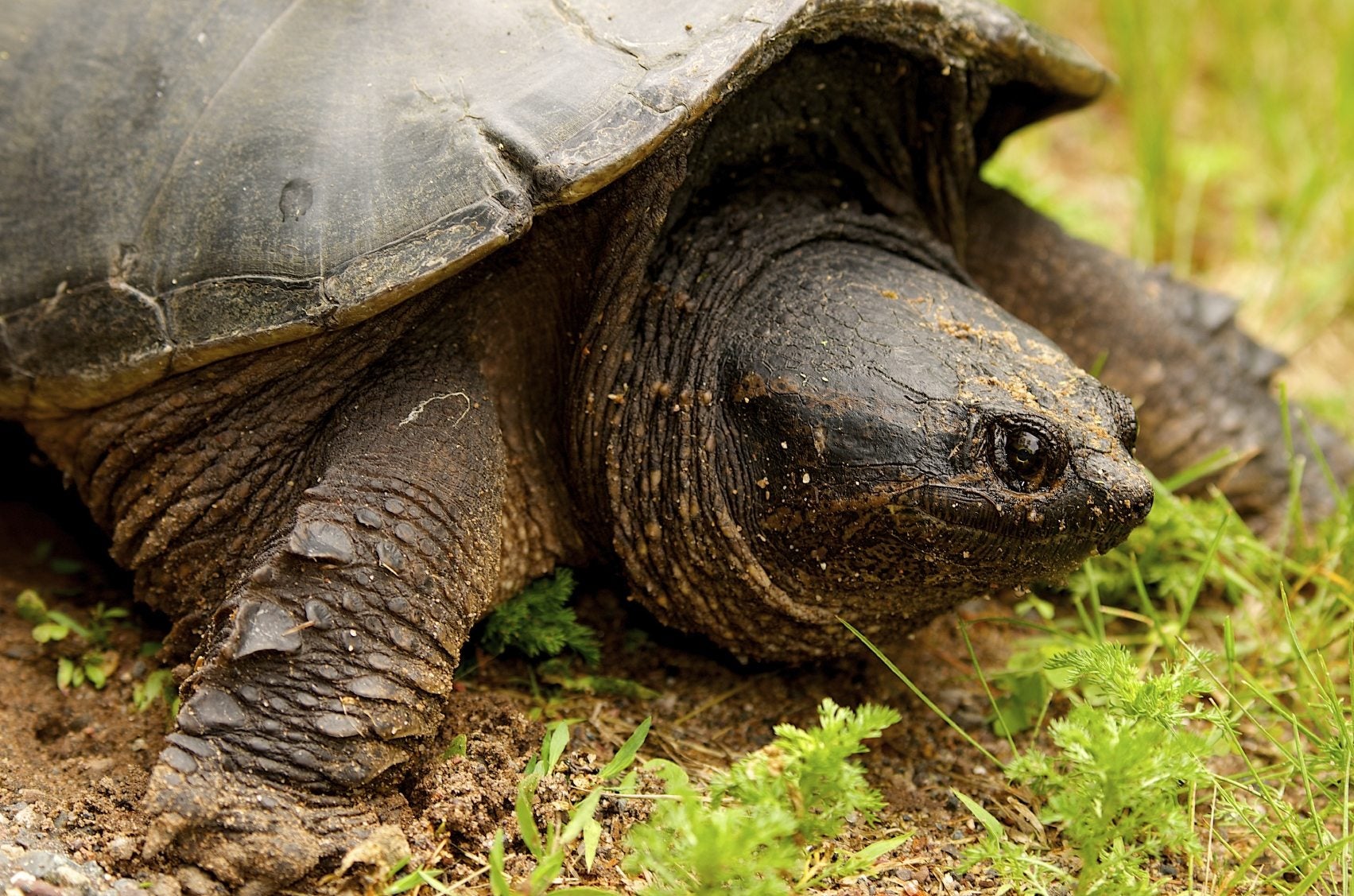To keep snapping turtles out of your yard, install a fence and remove potential nesting sites. Snapping turtles are attracted to sandy areas for nesting, so eliminating these spots can deter them from entering your property.
Additionally, keeping your yard free of debris and regularly mowing the grass can also make it less appealing for snapping turtles. It’s important to take proactive measures to prevent these creatures from causing any damage or posing a threat to pets or children.
By following these simple steps, you can create a safe and turtle-free environment in your yard.

Credit: dwr.virginia.gov
Understanding Snapping Turtles
Snapping turtles are fascinating creatures that can sometimes find their way into yards, causing concern for homeowners. Understanding their physical characteristics, habitat, and behavior can help in keeping them out of your yard.
Physical Characteristics
Snapping turtles have a large head, powerful jaws, and a long tail. Their shell can vary in color from dark brown to black, providing camouflage in their aquatic habitats.
Habitat And Behavior
Snapping turtles prefer freshwater habitats such as ponds, lakes, and streams. They are known to be solitary creatures and spend much of their time submerged in water, only coming on land to bask in the sun or lay eggs.
Reasons To Keep Snapping Turtles Out
To keep snapping turtles out of your yard, it’s crucial to secure any potential entry points and remove tempting food sources. Creating barriers with fences or mesh can prevent their access, while regularly clearing away debris and keeping your yard tidy can discourage them from lingering.
Reasons to Keep Snapping Turtles Out Snapping turtles are fascinating creatures, but having them in your yard can pose various challenges. It’s essential to understand the reasons to keep snapping turtles out to ensure the safety of your pets, children, and property. From potential threats to pets and children to protecting your garden and property, there are compelling reasons to take measures to keep snapping turtles at bay.Potential Threats To Pets And Children
Snapping turtles can be a potential threat to your pets and children. Their sharp beaks and powerful jaws can cause serious harm if they feel threatened or provoked. Keeping these turtles out of your yard is crucial to prevent any potential injuries to your beloved pets and little ones.Protecting Garden And Property
When snapping turtles invade your yard, they can wreak havoc on your garden and property. They are known to uproot plants, dig holes, and disturb landscaping, causing significant damage. By keeping snapping turtles out, you can protect your garden and property from these destructive behaviors. By understanding the reasons to keep snapping turtles out, you can take proactive steps to ensure the safety of your loved ones and the preservation of your property.Natural Deterrents
When it comes to keeping snapping turtles out of your yard, natural deterrents can be an effective and eco-friendly solution. By creating unfavorable conditions in your yard and utilizing natural predators, you can discourage snapping turtles from making themselves at home.
Creating Unfavorable Conditions In Yard
One effective way to deter snapping turtles from your yard is to make the environment less inviting for them. Keep your yard clear of debris such as piles of leaves, rocks, and logs, as these can provide ideal hiding spots and nesting areas for snapping turtles. Additionally, installing a fence with an underground barrier can prevent turtles from entering your yard. Avoid over-feeding wild animals as this can attract snapping turtles looking for an easy meal.
Utilizing Natural Predators
Another natural deterrent is to encourage the presence of natural predators that feed on snapping turtles. Attracting animals such as raccoons, foxes, and large birds of prey to your yard can help keep snapping turtle populations in check. These natural predators can help maintain a balanced ecosystem and reduce the likelihood of snapping turtles taking up residence in your yard.
Physical Barriers
To keep snapping turtles out of your yard, install physical barriers like fences or wire mesh around your property perimeter. These barriers can prevent turtles from entering your yard and protect your garden or landscaping from damage.
If you live near a body of water, chances are you’ll encounter snapping turtles in your yard at some point. While these reptiles may seem harmless, they can be aggressive and cause damage to your property. One effective way to keep snapping turtles out of your yard is by using physical barriers. Here are some options to consider:Fencing And Netting
One way to keep snapping turtles out of your yard is by installing a fence. The fence should be at least two feet high and made of material that the turtles cannot climb or dig under. Some effective materials include chicken wire, hardware cloth, and plastic mesh. If you have a pond or water feature in your yard, consider using netting to cover it. This will prevent the turtles from getting in and causing damage.Covering Ponds And Water Features
If you have a pond or water feature in your yard, covering it with netting or mesh is an effective way to keep snapping turtles out. The netting should be secured tightly around the edges to prevent the turtles from getting in. If you have fish in your pond, make sure the netting is fine enough to prevent the turtles from reaching through and grabbing them.Using Concrete Barriers
Another option to consider is using concrete barriers around the perimeter of your yard. These barriers can be buried underground to prevent the turtles from digging under them. They can also be placed above ground to create a physical barrier that the turtles cannot climb over. Keep in mind that concrete barriers can be expensive and may not be feasible for everyone. In conclusion, using physical barriers is an effective way to keep snapping turtles out of your yard. Whether you choose to install a fence, cover your pond with netting, or use concrete barriers, taking action to keep these reptiles out can save you time and money in the long run.Safe Removal And Relocation
To prevent snapping turtles from entering your yard, it’s crucial to implement safe removal and relocation methods. Contacting wildlife experts for assistance in relocating these creatures can help maintain a safe environment for both the turtles and your property.
Dealing with snapping turtles in your yard can be a challenging experience. Snapping turtles are known for their aggressive behavior and powerful jaws, which can cause serious harm to humans and pets. Therefore, it is essential to remove them from your property safely and relocate them to their natural habitat. In this section, we will discuss the process of safe removal and relocation of snapping turtles, including contacting wildlife professionals and proper handling and transport.Contacting Wildlife Professionals
When dealing with snapping turtles, it is always best to seek the help of wildlife professionals. These experts have the necessary tools and expertise to handle and relocate snapping turtles safely and effectively. They can also provide you with guidance on how to prevent snapping turtles from entering your yard in the future. Some wildlife professionals may charge a fee for their services, so it’s essential to research and compare different options in your area.Proper Handling And Transport
If you choose to remove the snapping turtle on your own, it is crucial to handle it properly to avoid injury to both you and the animal. When handling a snapping turtle, always wear thick gloves and hold it at the base of the shell, far from the head and tail. Do not pick up the snapping turtle by its tail, as this can cause serious injury. It is also important to transport the snapping turtle in a sturdy container with a secure lid to prevent escape. Ensure that the container is large enough for the turtle to move around comfortably and has adequate ventilation. In conclusion, keeping snapping turtles out of your yard requires a combination of preventative measures and safe removal and relocation practices. Contacting wildlife professionals and handling and transporting the turtle properly are crucial steps in ensuring the safety of both you and the snapping turtle. By following these guidelines, you can effectively remove snapping turtles from your yard and prevent future encounters.
Credit: blog.nwf.org
Respecting Local Regulations
Understanding Legal Restrictions
Before taking any action to remove snapping turtles from your yard, it’s crucial to understand the legal restrictions that may apply. Many regions have specific regulations regarding the handling and relocation of wildlife, including snapping turtles. Violating these regulations can result in fines or other legal consequences.
Permit Requirements For Relocation
Some areas require permits for the relocation of snapping turtles. Check with your local wildlife or environmental agency to determine if a permit is necessary before attempting to move a snapping turtle from your property. Failure to obtain the required permits can lead to legal repercussions and may also put the turtle at risk.
Community Involvement
Community involvement plays a crucial role in keeping snapping turtles out of your yard. By educating neighbors and collaborating on turtle-friendly initiatives, we can create a positive impact on the local turtle population.
Educating Neighbors And Community
Organize informative sessions to raise awareness about snapping turtles and their habitat needs. Highlight the importance of maintaining a balanced ecosystem and the role of turtles in it. Encourage responsible pet ownership to prevent conflicts with turtles. Distribute educational materials such as brochures or flyers to spread knowledge.
Collaborating On Turtle-friendly Initiatives
Work with local organizations and authorities to establish turtle crossing signs in areas frequented by turtles. Organize clean-up events to remove obstacles and litter that could harm turtles. Create designated nesting areas with guidance from wildlife experts to support turtle conservation efforts.
Conservation And Coexistence
Conservation and Coexistence:
Living in harmony with snapping turtles involves promoting turtle conservation efforts and creating balanced ecosystems.
Promoting Turtle Conservation Efforts:
- Support local turtle rescue and rehabilitation centers.
- Participate in community clean-up events to protect turtle habitats.
Creating Balanced Ecosystems:
- Plant native vegetation to provide food and shelter for turtles.
- Install turtle barriers around vulnerable areas in your yard.

Credit: dwr.virginia.gov
Conclusion
To sum up, preventing snapping turtles in your yard is crucial for safety. By following these simple steps, you can create a turtle-friendly environment. Remember to secure your property and avoid attracting them with food. Stay vigilant and protect both your family and the turtles.






Leave a Reply